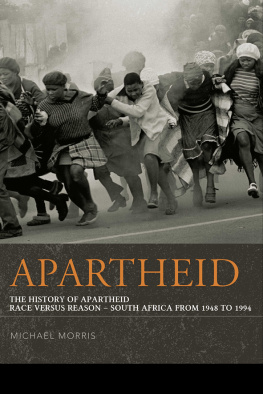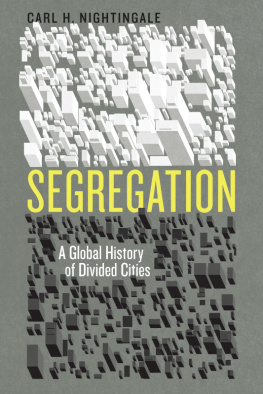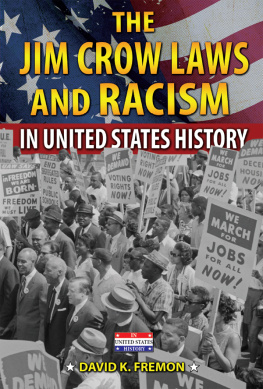University of Virginia Press
2017 Estate of Jeffrey Butler
All rights reserved
Printed in the United States of America on acid-free paper
First published 2017
9 8 7 6 5 4 3 2 1
Library of Congress Cataloging-in-Publication Data
Names: Butler, Jeffrey, author. | Elphick, Richard, editor. | Hopkins, Jeannette, editor.
Title: Cradock : how segregation and apartheid came to a South African town / Jeffrey Butler ; edited by Richard Elphick and Jeannette Hopkins.
Other titles: Reconsiderations in southern African history.
Description: Charlottesville : University of Virginia Press, 2017. | Series: Reconsiderations in southern African history | Includes bibliographical references and index.
Identifiers: LCCN 2017024791| ISBN 9780813940588 (cloth : alk. paper) | ISBN 9780813940595 (ebook)
Subjects: LCSH: SegregationSouth AfricaCradockHistory. | Cradock (South Africa)Race relationsHistory. | Cradock (South Africa)Social conditions20th century.
Classification: LCC DT2060 .B88 2017 | DDC 305.8009687560904dc23
LC record available at https://lccn.loc.gov/2017024791
Cover art: Detail of Cradock from the south, from Regent Street toward the town center, c. 1933. (Museum Africa, Johannesburg, South Africa)
RECONSIDERATIONS IN SOUTHERN AFRICAN HISTORY
Richard Elphick, Editor
EDITORS PREFACE
This publication testifies to the high esteem that Jeffrey Butler and his scholarship enjoyed among his colleagues. He began his research in Cradock in 1977, and over the next two decades gave numerous presentations, most notably at the Yale-Wesleyan Southern African Research Program, that aroused intense anticipation among South Africanists for the promised book. Tragically, on 13 November 2001, he suffered a debilitating stroke that ended his involvement in the project. He died in April 2008.
By 2001, Butler had completed a manuscript that was heavily documented and publishable without additional research. But it required considerable cutting and editing. The renowned editor Jeannette Hopkins, then the director of the Wesleyan University Press, had worked closely with Butler in shaping the structure of his argument and was determined that the work should be published. She then produced meticulous line editing that became the basis for my own work on the manuscript. Sadly, she died in August 2011, long before her devoted efforts saw the light of day.
My principal goals were to streamline the manuscript while retaining Butlers distinctive voice as much as possible. At the final stage, Jeffrey Butlers daughter Katy, herself an eminent author, provided helpful suggestions on the entire manuscript. In light of the expert assistance I received from Jeannette Hopkins and Katy Butler, it is important to stress that I, as a historian of South Africa, made the final decisions on matters both major and minor. Thus, to the extent that errors remain that are not attributable to Butler, the blame is entirely mine.
It is not possible to know whom Butler would have thanked for helping him during his research, although it is certain that he would have effusively praised his wife, the late Valerie de la Harpe Butler, who had supported him heroically, both in good times and bad. And Fran Warren of the College of Social Studies at Wesleyan deserves thanks for expertly typing Butlers many drafts.
In part because Butlers memory is so widely revered at Wesleyan, I have been generously supported in this venture by a series of Wesleyan grants and by the moral support of numerous department chairs, deans, and provosts at Wesleyan University. I am particularly grateful to Judith Brown, Brian Fay, Joyce Jacobsen, Don Moon, and Gary Shaw.
The manuscript I inherited included numerous detailed endnotes. Admirably compact, they relied heavily on acronyms. Deciphering the acronyms was the first challenge faced by Susan Sturman, a retired librarian in Cape Town, who undertook the heroic task of identifying, first, the archives and, then, the relevant files where Butler had done his research, in order to fact-check both notes and text. It was a tiring, often dispiriting enterprise, which she undertook with determination, resourcefulness, and her characteristic good humor. She was assisted by the work of Adam Tinkle, an outstanding Wesleyan undergraduate, who checked several series that Butler had purchased on microfilm. Sadly, Sturman died in April 2016.
Butler left photocopies of many images he wished to accompany the book. Elizabeth de Wet, a retired archivist in Grahamstown, pursued clue after clue with relentless enterprise and managed to locate several of the originals. When, however, it became apparent that many of Butlers desired images had been lost, she worked with me to locate appropriate substitutes. The images we found are not as numerous or, in some cases, as germane as Butler had wanted, but we are pleased to present them nonetheless. She and I are both grateful to Brian Wilmot, curator of the Olive Schreiner House Museum, who helped immeasurably in searching for images in Cradock.
Mariah Reisner, under my direction, and with technical advice from Kevin Wiliarty, used the computer to produce the admirable maps that accompany this text. I am grateful for Reisners ready grasp of the historical issues as well as for her technological competence.
I am greatly indebted to Katy Butler, who, as executor of her fathers will, has provided not only cogent advice but also financial support from the estate to support publication. She also slightly amplified and amended the Authors Preface in light of her knowledge of Butler family history.
I received strong and unwavering support from Dick Holway, Mark Mones, and the staff of the University of Virginia Press. In particular, Bonnie Gills understanding, good cheer, and efficiency helped me greatly in acquiring illustrations and permissions and in crafting acceptable copy for the maps. Jane Curran, my copy editor, was both meticulous and flexible in dealing wth the difficulties of editing a book by a deceased author. And Enid Zafran, quickly gaining a firm grasp of the intricacies of South African and Cradock governance, produced an admirably thorough and accurate index.
All translations are by Butler, unless otherwise indicated.
Richard Elphick
AUTHORS PREFACE
In mid-1977, after living and teaching for nearly four decades in England and America, I returned to South Africa on a U.S. National Endowment for the Humanities fellowship to collect material for a history of Cradock, the small town where I was born.
I reached the town from the south on a new national road along the wide, rocky, and nearly dry Great Fish River, which runs here on the edge of the Great Karoo semi-desert, a landscape of koppies (rocky outcroppings) and tafelberge (table mountains) rising from a thirstland of low gray bush. Here white settlers, from the Netherlands and the British Isles, established themselves from the 1780s on, marking out large sheep and goat farms on lands that had once been pasturage for the cattle of the Xhosa people, and building towns and garrisons fifty miles apart. To the left of the road, about six miles from Cradock and rising two thousand feet above the valley floor, was the familiar sight of Buffelskop (Buffalos Head), where the South African novelist and feminist social reformer Olive Schreiner, author of The Story of an African Farm, was buried in 1923. When I was a child in the 1920s and 1930s, I sometimes accompanied my aunt Mary Butler, a Quaker nurse active in liberal causes in Cradock, on the expeditions she organized to Buffelskop for visitors and those of her nephews and nieces who had the interest and energy to make the climb. Often she would lecture us on the importance of Schreiners ideals for the future of South Africa.








